
Art's Emotional Power: Crafting Soulful Spaces for Well-being
Discover how art transforms your home into a soulful sanctuary. A decorator's guide to color, form, and curation for emotional well-being and self-discovery.
Art's Emotional Power: Crafting Soulful Spaces for Well-being
My fascination has always been with the soul of a space. Not just its physical layout or the latest trends, but that intangible, palpable energy a room holds, the silent language a home speaks. I distinctly recall walking into a client's pristine, 'perfectly designed' penthouse early in my career. Every surface gleamed, every piece of furniture was exactly where it should be, yet a subtle emptiness hung in the air. No heartbeat. No stories. It felt transient, like a lavish hotel lobby, not a home brimming with life. I remember a similar feeling visiting a friend's new, spotless apartment; the bare walls just amplified the quiet void. This genuinely baffled me for a while. Then, one crisp morning, as I sipped my coffee and stared at a particularly sterile wall, it hit me: the furniture, the paint, they weren't the real story. It was about the art, or more often, the glaring absence of it. That moment felt like a curtain being pulled back, revealing a profound truth.
It was then I truly understood: art isn't merely decoration. It's a silent conversation, a profound emotional landscape, a potent secret ingredient I wield to craft spaces that genuinely nourish the soul. A good piece of art does far more than just look pretty; it whispers to your subconscious, shifting a room's very energy and profoundly impacting your mental well-being.
I've noticed many people shy away from art. Maybe they think it's too expensive, or they don't trust their own taste (and who does, really, at first? Spoiler: almost no one!). Perhaps they're just afraid of making the 'wrong' choice. But by leaving their walls bare, they're missing out on a powerful, often effortless, way to nourish their spirit. They're missing the chance to transform a house into a soulful home. And in our increasingly busy, often overwhelming world, cultivating these personal sanctuaries has never been more important.
Today, I want to pull back the curtain even further. We'll dive deep into how color, form, and composition weave their magic, how to intentionally curate these elements, and ultimately, how engaging with art becomes a unique journey of self-discovery. Let's explore how art can cultivate your emotional landscape and transform your home into a truly soulful sanctuary, starting with the very first brushstroke of feeling.
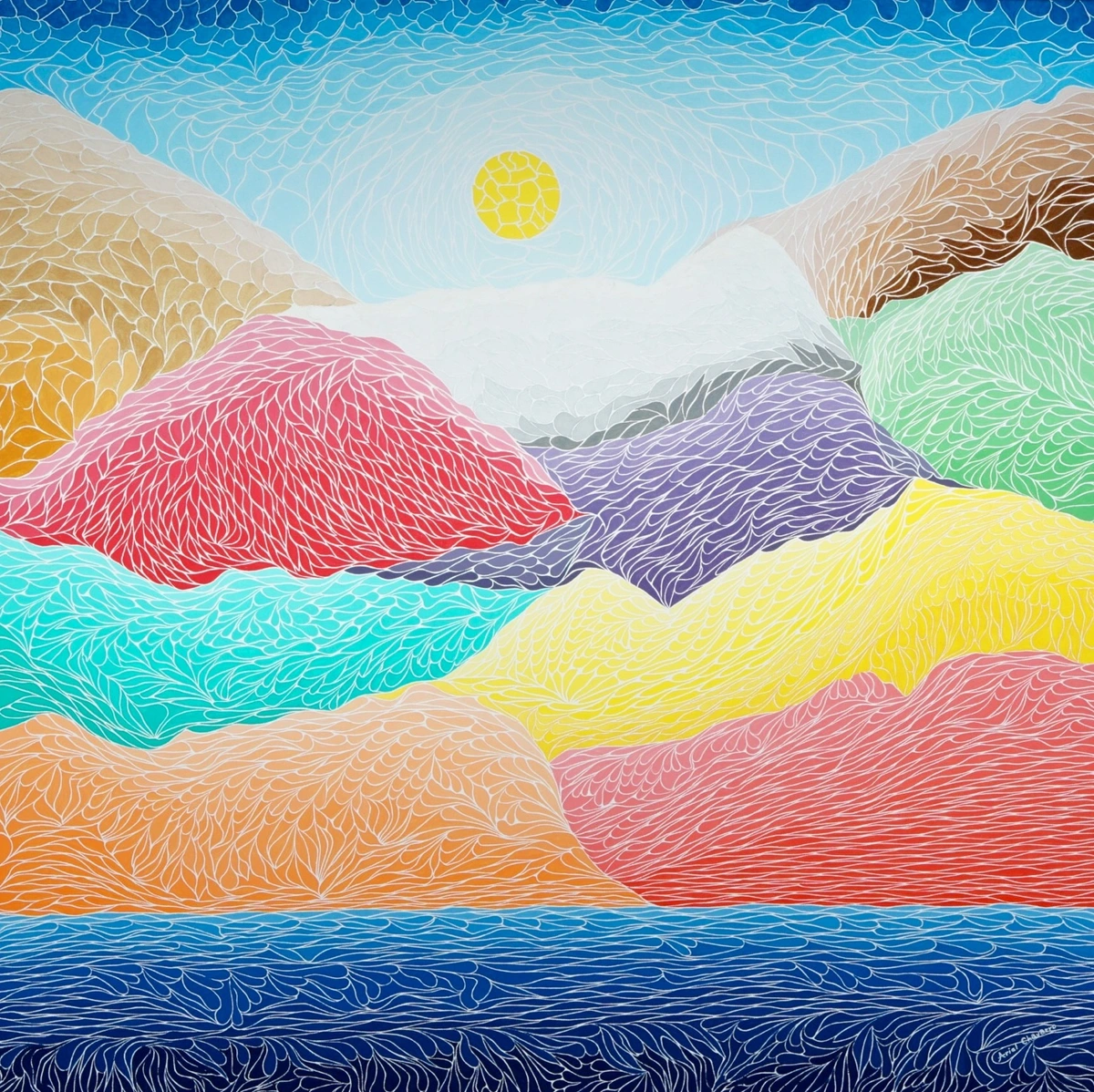
Color as a Mood Architect: Beyond Basic Hues
Confession: When I first started out, I saw color as just... well, colorful. A decorative choice, a bit like thinking a symphony is just a bunch of notes, utterly missing the intricate harmony. My younger self, bless her heart, probably just thought, 'Oh, that's a nice blue!' without a single thought to its deeper implications. But after years of witnessing people's visceral reactions to it in their most intimate spaces, I realized color is a powerful, silent architect of mood. I had a client once, a rather stoic gentleman who insisted on muted tones. One day, I convinced him to try a small abstract piece with a surprising splash of deep magenta in his study. Weeks later, he admitted, almost sheepishly, that the magenta had become his 'secret spark,' giving him a quiet energy boost during long workdays. These subtle shifts truly reveal color's power.
What I've learned is that the psychology of color goes far beyond basic hues. Colors aren't merely pigments; they are potent emotional triggers, directly impacting our limbic system. This isn't just poetic fancy; studies show colors can influence physiological responses like heart rate and even appetite, acting as direct conduits to our well-being. This is also where understanding color temperature and color saturation comes in. Highly saturated colors (think a vivid, intense red) are potent and commanding, excellent for energy but potentially overwhelming in large doses. Less saturated colors (a soft, muted pink) tend to be more soothing and subtle, ideal for relaxation.
Of course, it's worth noting that while some color principles are universal, cultural context can subtly shift our interpretations. A color that signifies joy in one culture might represent mourning in another, which is why understanding your own connection to a hue is paramount.
Consider a room bathed in vibrant reds and oranges. Energizing, stimulating, right? Perhaps ideal for a creative studio where you need a burst of inspiration, or a bold dining room à la Matisse's The Red Room, its inviting vibrancy encouraging lively conversation and a sense of shared warmth. In stark contrast, imagine a piece dominated by deep indigos and muted grays; it instantly creates a sense of profound calm, almost a visual lullaby, perfect for unwinding.
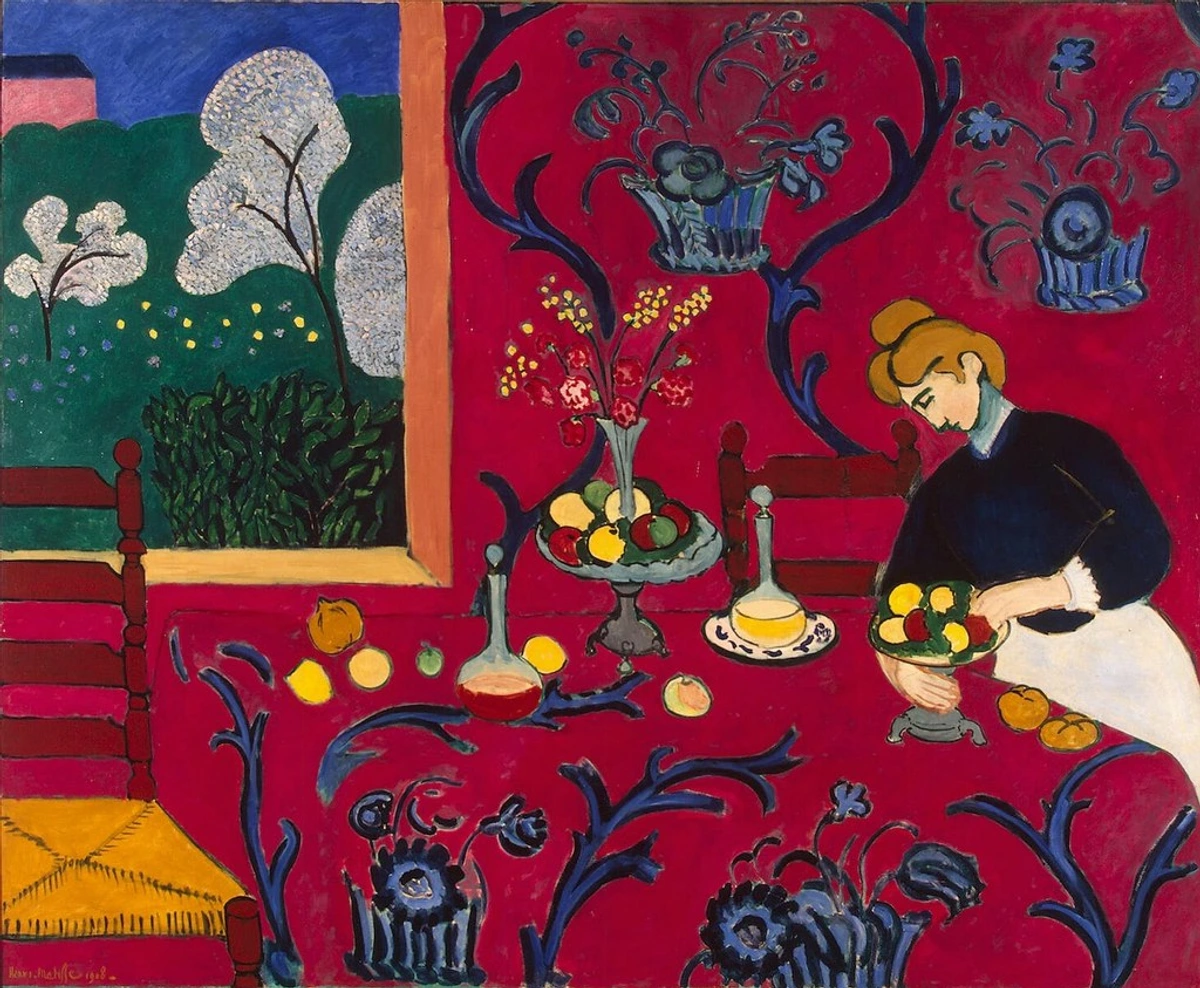
But for a bedroom, a sanctuary meant for unwinding? Perhaps not so much. Conversely, soft greens and blues, echoing nature's palette – like those muted, expansive blues found in a deep ocean abstract or the gentle greens of a misty forest painting – are renowned for promoting tranquility and reducing anxiety, connecting directly to the concept of biophilia, our innate human tendency to connect with nature. For me, personally, discovering the healing power of color was a profound realization – I learned that a burst of deep indigo could literally quiet my racing thoughts, acting like a visual lullaby. It's truly like having a quiet friend on your wall.
And we can't forget the silent partner of color: light. Whether it’s the soft glow of morning sun shifting across a canvas, revealing new textures, or the intentional play of artificial lighting enhancing specific hues, light dramatically influences how we experience color in art. A piece that feels vibrant under midday light might transform into a contemplative, moody statement by the evening, simply by how the light interacts with its surface.
Beyond individual hues, how colors interact within a piece also plays a huge role. Think about complementary colors – those opposite each other on the color wheel, like blue and orange. When placed together, they create a vibrant contrast, a visual tension that can be incredibly dynamic and engaging. This can be fantastic for a piece meant to spark conversation or invigorate a space, but might be too stimulating for a tranquil zone like a bedroom.
Don't forget, it's also about color harmony – how colors interact within a single piece, creating a nuanced emotional tapestry rather than just a single dominant feeling. A canvas with vibrant yellows softened by muted grays, for example, can evoke both energy and stability simultaneously, like a bright day at the quiet end of a bustling city park. Conversely, clashing, unharmonious colors can create visual tension, which might be exciting in a gallery but less ideal for a serene living space.
When selecting a piece, I always encourage my clients to think about the feeling they want to cultivate. Do they need an escape? A burst of energy? A gentle reminder to slow down? The colors in a painting, even a hypothetical abstract piece with a dominant deep indigo blended with streaks of soft silver, can deliver precisely that feeling of nocturnal calm or quiet reflection.
Color Family | Emotional Impact (General) | Ideal Room Application (Examples) |
|---|---|---|
| Warm (Reds, Oranges, Yellows) | Energy, stimulation, passion, warmth, joy | Creative studios, dining rooms, vibrant living areas |
| Cool (Blues, Greens, Purples) | Calm, tranquility, peace, relaxation, serenity | Bedrooms, meditation spaces, bathrooms, quiet nooks |
| Neutrals (Grays, Whites, Beiges) | Balance, sophistication, grounding, clarity | Any room, often as a base for other colors or to highlight art |
Ultimately, color is your silent partner in setting the mood. What mood are you hoping to create today, and what colors are whispering to your soul?
Form, Composition, and Texture: The Unseen Structure of Calm
So, we've talked about the emotional fireworks of color. But what about the quiet rhythm, the underlying structure? Beyond the vibrant language of color, the very structure of an artwork – its lines, shapes, and textures – also contributes significantly to the emotional resonance of a space. It's like the subtle rhythm beneath a melody, the quiet architecture of calm. The composition, the style, and even the palpable texture of a piece are equally potent in shaping our internal state.
Think about geometric abstraction – those clean lines, bold shapes, and often rhythmic patterns. For some, the precise angles and defined boundaries of geometric abstraction can feel like a comforting anchor, offering a sense of clarity amidst life's chaos. A piece by someone like Robert Delaunay, with his rhythmic circles and sharp lines, for example, embodies this sense of stability and dynamic order.

For others, it might feel a bit too rigid, a bit too intellectual. It truly is about finding that 'sweet spot' where the art's structure harmonizes with your inner sense of order or desire for calm, steering clear of anything that might stir unease. I often find myself explaining understanding line in abstract art to clients, not as a lecture, but to show them how different lines can evoke movement, stability, or even a sense of playful chaos. And when we talk about lines, let's consider line weight. Thick, bold lines can convey strength, stability, or even a raw energy, while thin, delicate lines might suggest fragility, grace, or a whisper of movement. It's another subtle layer that shapes our emotional response. The subtle symbolism in the symbolism of geometric shapes can tap into very primal responses, creating an unconscious sense of balance or dynamism.
In contrast, the fluid, curving forms of organic abstraction – distinct from the rigid angles of geometry, mimicking natural forms without literal representation, or biomorphic forms which directly reference biological shapes – or the soft, flowing lines characteristic of lyrical abstraction and more gestural styles, can induce a profound sense of calm and gentle flow. Imagine an abstract piece by an artist like Helen Frankenthaler, with its harmonious washes of color and expansive, serene palettes, mimicking the natural world's inherent tranquility without being literally representational; it's like bringing a piece of a peaceful landscape indoors. It feels like a quiet sigh. Or consider the joyful, fluid shapes of a Matisse cut-out – they dance with an inherent, natural grace.

Beyond the lines and shapes, the very presence and placement of art within a space also dictates its emotional impact, which brings us to scale and proportion. A tiny piece on a huge wall can feel lost, almost sad, while an oversized piece in a small room can feel suffocating. It’s all about creating visual balance and flow, ensuring the art doesn't just hang there, but truly belongs to the space. And crucial to this is negative space – the empty areas around and within the artwork. In art, and especially in a room, negative space isn't just 'nothing'; it's crucial for visual balance, giving your eye a place to rest and enhancing focus on the art itself, contributing to a sense of calm.
Then there's texture. A heavily impastoed painting, with its palpable peaks and valleys, can add a tactile dimension that invites closer inspection and a deeper sensory experience, grounding you in the present moment. Think of Gerhard Richter's scraped surfaces – almost primal. A raw, rough texture might feel earthy and grounding, like solid rock, inviting a feeling of authenticity, while a piece with a smooth, almost glassy finish might evoke calm sophistication, like still water. The very medium used – whether it's the rich physicality of oil on canvas, the airy translucence of watercolor on paper, or the sleek precision of a metal sculpture – inherently contributes to this tactile and visual texture. Some abstract art even incorporates found objects or unconventional materials, adding another layer of tactile and visual intrigue. It’s a sensory experience that draws you in and connects you deeper to the art.
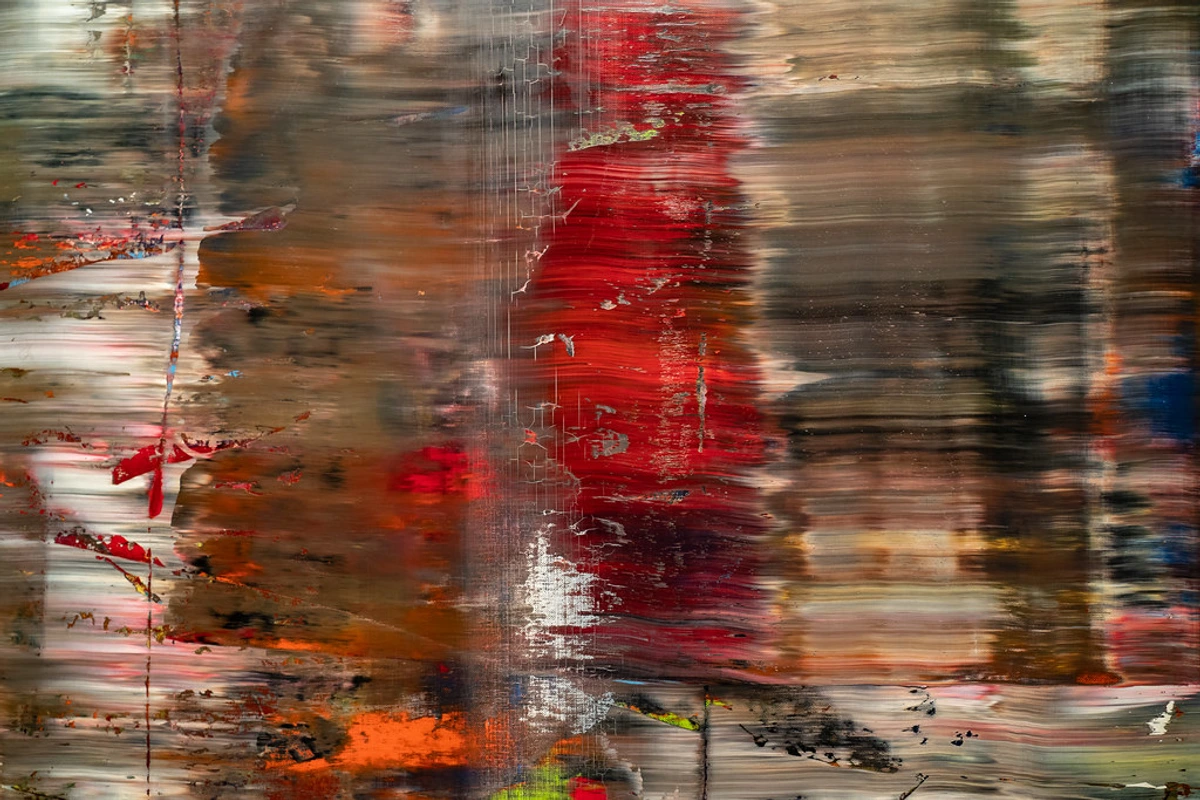
Understanding the essence of design in art is fundamental to my goal of creating a harmonious environment. Of course, sometimes art can evoke discomfort or even challenging emotions. As a decorator, part of my job is figuring out how much 'challenge' a client actually wants. Because while art can provoke thought – a gentle nudge outside our comfort zone – my primary goal is to ensure it boosts, not drains, the daily emotional environment. Unless, of course, the intention is to deliberately provoke thought or challenge in a beneficial way. Even within abstract art, you find diverse styles: from the raw, unbridled energy and emotional intensity of abstract expressionism (think Pollock's drips, for instance, which can feel both chaotic and deeply expressive) to the stark, often meditative simplicity of minimalism (where absence is as important as presence, inviting contemplation rather than overwhelming the senses). Each offers a different emotional dialogue, and each has a place.
So, what shapes your serenity, or perhaps, what kind of dynamic challenge sparks your curiosity in your own space?
The Silent Conversation: When Art Whispers to Your Soul
Isn't it fascinating how art just... gets us? It has this incredible ability to bypass our logical minds and speak directly to our emotions, creating a profound, silent dialogue within us. That experience with my client, the one with the 'perfect' but lifeless penthouse, perfectly illustrates this. I vividly recall another client, a high-flying executive perpetually caught in the whirlwind of her demanding career. Her living room was 'perfect' by every conventional design metric – yet it felt utterly devoid of warmth, almost clinical. My intervention? A large, serene abstract piece, a canvas awash with soft blues and gentle, undulating movements. Weeks later, she called, almost in disbelief, to tell me she felt a profound sense of calm just walking into that room. The art, she said, had given the room a heartbeat, a quiet invitation to breathe.
Historically, art in domestic spaces was often about status or literal storytelling. Think about grand portraits or elaborate tapestries in old manor homes. But somewhere along the way, especially with the rise of Modernism and Abstract Expressionism, we started asking for more. We began craving pieces that spoke to us, not just about our lineage or social standing. This shift from art as a symbol to art as a soul connection is a beautiful evolution, continuing even through post-modern and contemporary movements, where personal connection and emotional resonance often take precedence over grand narratives.
Art, especially abstract art, doesn't dictate what you should think; it simply invites you to feel. It's like art has a secret handshake with our gut feelings, bypassing overthinking to go straight for the emotional core – our limbic system. From a psychological perspective, this engagement can be understood through concepts like Gestalt principles, where our brains naturally seek to find meaning and wholeness in fragmented or abstract forms. For example, encountering an abstract piece with a dominant, open spiral might subconsciously evoke a feeling of continuous growth or expansive possibility, offering a 'cognitive completion' that resonates with our inner experience. Beyond that, art fosters aesthetic engagement, which studies suggest can reduce stress and enhance feelings of pleasure – it's basically just enjoying beautiful things, like the satisfying click of a perfectly closed door or the calming symmetry of a well-organized bookshelf, but with a fancy name! Like a beautiful piece of music that moves you without needing to analyze its structure, art does the same for the eyes and the soul, offering a form of catharsis as emotions are stirred and then gently released.
Interestingly, regular engagement with art can even contribute to neuroplasticity, which is just a fancy way of saying our brains are incredibly adaptable. By consistently exposing ourselves to art that evokes calm or joy, we subtly reshape our neural pathways, becoming more receptive to beauty and tranquility over time. Think of it like regularly practicing gratitude; it trains your brain to notice positive things. Art does a similar workout for your emotional muscles. And if you're curious about diving deeper, there's a whole world to explore in meditating with an abstract painting.
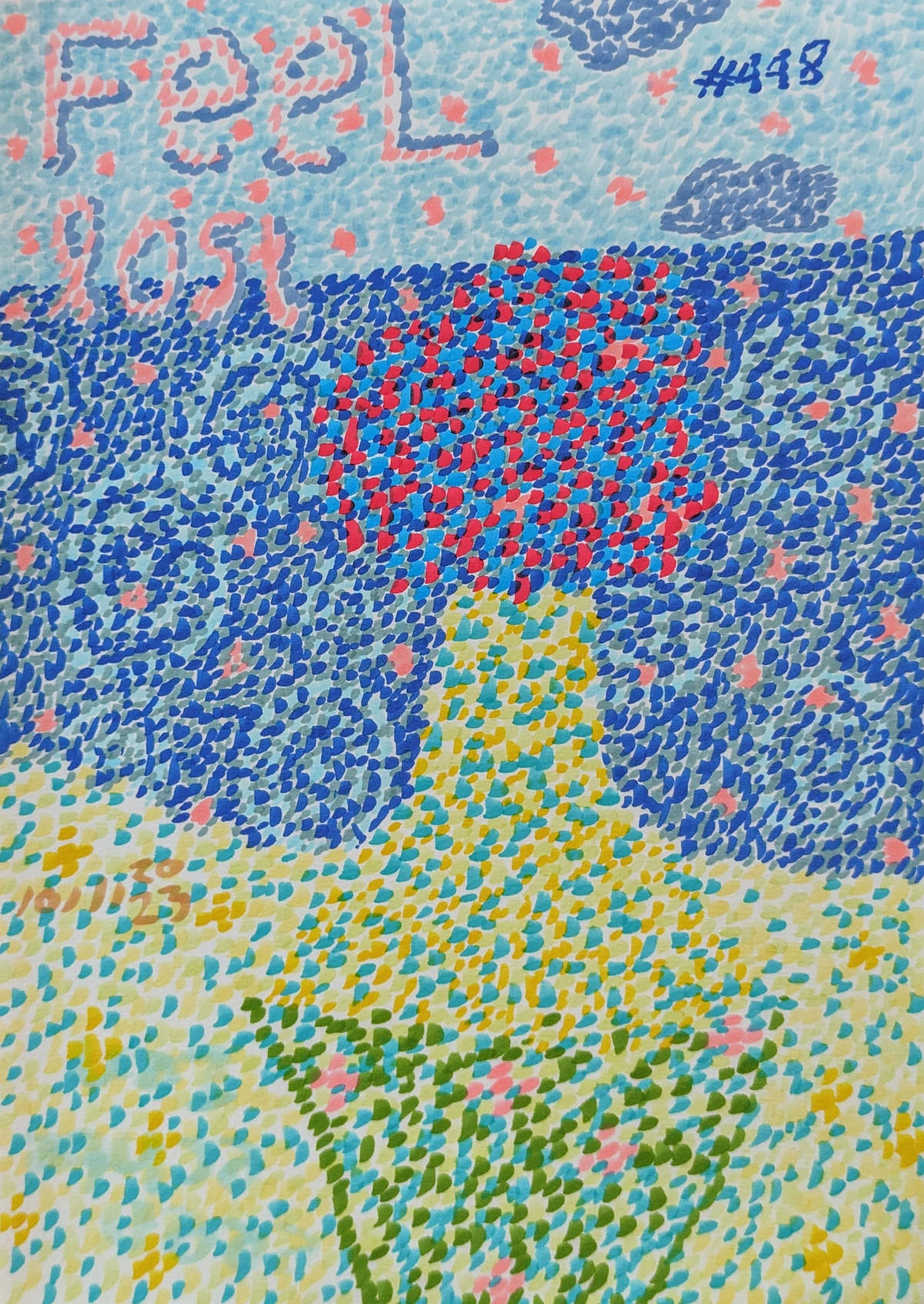
Now, it's worth a beat to acknowledge that our personal interpretation of art, and its emotional punch, is deeply colored by our individual background, our lived experiences, and even those deep-seated, subconscious connections we make with universal archetypes. (Think of archetypes as universal symbols or patterns – like the 'hero' or 'mother' – that resonate deeply across cultures.) For instance, a circular motif in an abstract piece, even if it's just a soft, undefined circle, can tap into the archetype of 'wholeness' or 'unity,' subtly evoking feelings of completeness and peace. Or perhaps jagged lines might unconsciously evoke a sense of 'struggle' or 'breakthrough.' What speaks to one may sing a different song to another – that's its beauty. This deeply personal resonance means art can also serve as a powerful vehicle for expressing our personal identity and values within our home, turning a mere dwelling into a reflection of who we are. It can also serve as a powerful trigger for memory and nostalgia, evoking cherished moments and contributing to a sense of personal history within a space.
And remember, this isn't just about paintings. Sculptures, textile art, photography, thoughtfully chosen pottery, or even stunning digital art – each medium brings its own unique texture and form to this silent conversation. Sculptures offer three-dimensional presence and interaction with light, textile art introduces warmth and tactile softness, photography captures fleeting moments of profound emotion, and digital art opens up dynamic, evolving visual experiences, enriching the emotional landscape of your home in distinct ways.
So, what kind of silent conversation does your home need, and what hidden dialogues might you uncover?
Curating Your Sanctuary: A Decorator's Touch
Now, once we understand the intrinsic elements of art – all those colors, forms, and textures – the real magic begins: intentionally weaving them into our living spaces. My job, truly, is to be a guide, a sort of emotional architect for your walls. And for me, as an an artist who pours my own emotions and experiences onto canvas, there's nothing more rewarding than seeing that connection spark for someone else. I find it's a delicate dance between listening intently and interpreting subtly, helping people connect with art that genuinely resonates with them, not just with what’s 'fashionable' or what they think they should like. It's about crafting a space that feels like them, a space that expresses their personal identity and values within their home, and one that truly feels like home, fostering a deep sense of place and belonging. This is especially vital for those who, like me, might move often; art provides a consistent, soulful anchor.
This means going far beyond simply matching a sofa. My process always starts with deeper questions, because a home should feel like a story, and I want to understand your narrative. I ask: What kind of energy do you want to feel when you wake up each morning? What truly helps you decompress after a long day? Where do you instinctively seek inspiration or solace, or even a spark for creativity and innovation? And, perhaps most importantly, how will a new piece join the existing conversation, either by complementing or thoughtfully contrasting with your current art, creating a cohesive emotional narrative throughout your home?
Then, it’s about practicalities, because even the most profound piece needs the right stage. The process of selecting art for your home often begins with a journey – a visit to a local gallery, hours spent browsing online (you can even find pieces that speak to you in my collection of art), or a slow, thoughtful walk through a museum. Trust your intuition; the piece that makes you pause, that subtly shifts something inside you, is often the right one, regardless of its price tag.
The philosophy behind abstract art for every room isn't just a catchy title; it's a blueprint for mindful living. We consider the scale of the room itself, not just the wall space – after all, a massive painting in a tiny room can feel overwhelming, while a postage stamp on a huge wall simply gets lost. Decorating with large-scale abstract art can literally change the perceived size and mood of a room, transforming a cramped space into an expansive vista. But even smaller, thoughtfully placed pieces can act as powerful visual anchors, drawing the eye and grounding the space. We can also use art to define different zones within an open-plan living space, perhaps a vibrant piece to delineate a creative corner and a serene one for a reading nook, each creating a distinct mood for different activities.
We also think about placement and lighting, because the art of display is crucial for how a piece is experienced. After all, a stunning artwork hidden in shadow is a missed opportunity for daily joy. And it's not just artificial light; the way natural light plays across a canvas throughout the day can dramatically alter its colors and textures, transforming its mood from morning to evening.
For those worried about budget, remember that impactful art doesn't have to be expensive – prints, pieces from emerging artists, or even thoughtfully chosen secondhand finds can be incredibly soulful. The real value isn't in the price tag, but in the resonance it creates within you and your home. Sometimes, investing in a smaller piece that truly speaks to you is far more enriching than a huge, generic decor item. And while art can be a significant investment, its primary role in a home, for me, is always about enhancing daily life and emotional well-being, though the satisfaction of knowing a piece holds long-term value is certainly a bonus.
It's also worth considering the ethical considerations of art acquisition, which means supporting the artists whose work you love by buying directly or from reputable galleries, understanding the provenance of a piece (its history of ownership), and avoiding anything that might have been unethically sourced. For me, being a responsible, mindful collector means ensuring the art I bring into my home carries not just aesthetic value, but a clear, positive story of its origin.
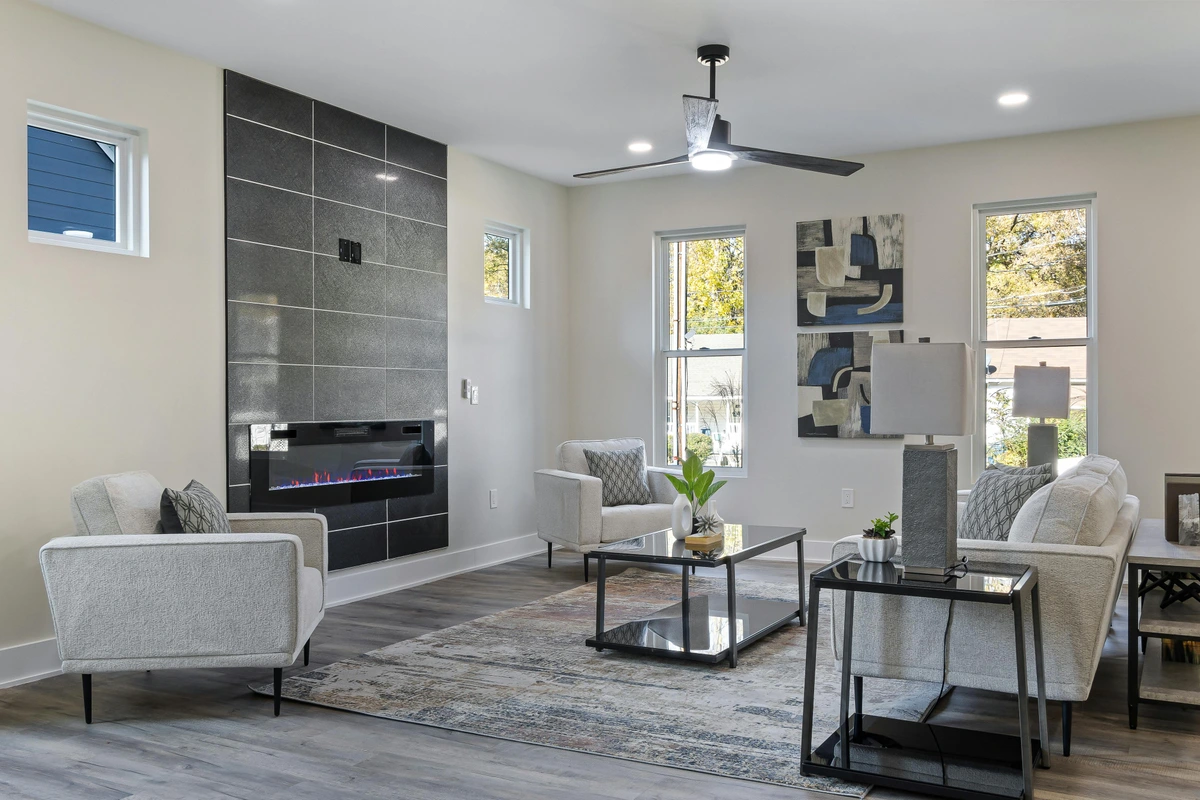
How do you envision your sanctuary today, and what feelings are you ready to cultivate within its walls?
Beyond the Frame: Art as a Journey of Self-Discovery
Think about it: choosing art is, in itself, a mindful journey. It’s an act of self-reflection, a rare chance to explore what truly resonates with your inner world. In a world full of noise, taking the time to truly look at a piece, to feel its energy, is a quiet act of rebellion and self-care. It’s a powerful path to self-discovery, which is why I champion concepts like mindful moments with abstract art.
This process also highlights the fascinating dynamic between the artist's intent and the viewer's interpretation. While an artist may infuse a piece with specific emotion or meaning – perhaps a burst of color to signify joy – it is ultimately your personal connection and experience that shapes its impact on your well-being. This interaction is a beautiful example of semiotics, the study of signs and symbols, where the 'signs' (colors, shapes, textures) in an artwork acquire personal meaning for the viewer. You might, for example, find a calming stillness in that same burst, or a completely different narrative. It becomes a shared secret, a personal dialogue. And understanding a bit about the artist's process – the layers, the brushstrokes, the choices made – can deepen that appreciation, drawing you further into the art's story and making it even more impactful.
And this journey isn't just solitary. Interestingly, art can also serve as a powerful conversation starter, sparking connection and shared contemplation among those in your home. I've seen a single painting ignite hours of discussion at a dinner party, with guests sharing wildly different interpretations and revealing layers of personality and shared experience. Sometimes, a collection of pieces even tells a quiet narrative about the inhabitants themselves, acting as a visual autobiography. It reflects their journey, their passions, their evolving tastes, and the stories they choose to live with every day. It's truly a legacy in motion, a visual chronicle that gains depth and meaning over time, potentially becoming a cherished heirloom passed down through generations, each adding their own layer to its story.
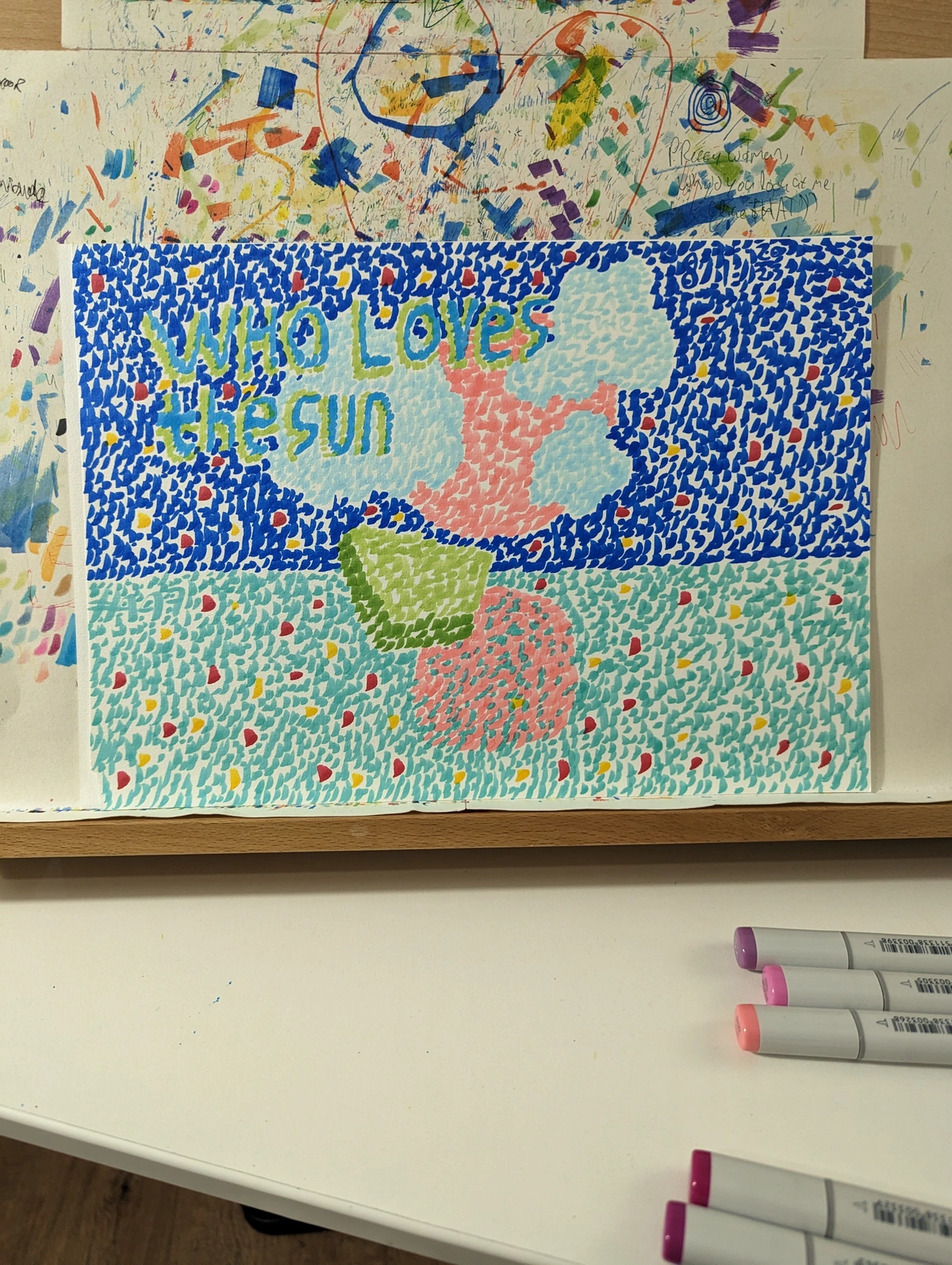
One of the most rewarding aspects of my work is seeing the transformation, not just of a room, but of the people who live in it. It's a beautiful thing, really, how a well-chosen painting can become a daily source of comfort, inspiration, or just a moment of quiet reprieve from the world. Its mere presence can foster a meditative state, acting as a form of art therapy for anxiety and stress. I recall a specific project where we used a single, powerful abstract painting to transform a rather sterile living room into a cozy haven, a story similar to what’s explored in a case study on transforming a living room with art. The shift in the client’s demeanor after the installation was palpable. It wasn't just decor; it was a profound environmental, and personal, change.
What unique changes could art bring to your space and self-discovery journey, starting today?
Frequently Asked Questions (FAQ)
Curious about how art can truly transform your space and mood? Here are some common questions I hear, and my thoughts on them:
How does color in art specifically affect mood?
Ah, color! It's like a secret language for our emotions, isn't it? Different colors can evoke distinct psychological and even physiological responses. Warm colors (reds, oranges, yellows) often energize, stimulate, and can subtly increase metabolism, making them suitable for active spaces like a kitchen or dining room. Cool colors (blues, greens, purples) tend to calm, soothe, and reduce anxiety, promoting relaxation – perfect for bedrooms or meditation nooks. The specific shade, intensity, and combination with other colors also play a crucial role in the overall emotional impact. As a decorator, I focus on understanding these nuances to match art with the desired feeling for a room, always considering the unique light and existing elements of the space.
Can abstract art really improve mental well-being?
Absolutely. I often get asked about this! Abstract art, by its non-representational nature, invites personal interpretation and emotional engagement without dictating a specific narrative. This can be very liberating and meditative, allowing the viewer to project their own feelings and find unique meaning. It often acts as a visual anchor for contemplation, reducing mental clutter and fostering mindfulness, much like mindful moments with abstract art. The ambiguity can be a powerful tool for self-discovery and emotional processing, offering a safe space for reflection, sometimes even resembling aspects of formal art therapy in its calming effect.
What art is best for creating a relaxing bedroom atmosphere?
For truly relaxing spaces, I generally recommend art with soft, harmonious color palettes – think gentle blues, greens, muted grays, or earthy tones. Compositions with flowing lines, organic shapes, or expansive, uncluttered elements tend to promote a sense of calm. The goal is to create a visual escape that encourages rest and tranquility, rather than stimulation. Avoiding overly complex or highly contrasting pieces is often key here.
How do I choose art for specific rooms like a home office or dining room?
This is a fun design challenge! For a home office, I'd suggest art that inspires focus and subtle energy, without being distracting. Geometric abstracts or pieces with clean lines in cool, calming colors (blues, greens) can definitely enhance concentration, always keeping the scale and proportion of the room in mind. For a dining room, you might want art that encourages conversation and warmth. Warm colors, perhaps a slightly more dynamic composition, or even pieces that evoke a sense of abundance or shared experience can be wonderful. And for a child's room, I love recommending playful, imaginative pieces with bright, yet not overwhelming, colors that spark joy and creativity. Visual engagement with art can even aid in their cognitive and emotional development.
What if art makes me feel uncomfortable or challenged?
That's a really insightful question, and honestly, it happens! Sometimes art is meant to challenge us, to make us think, or even to evoke complex emotions. As a decorator, my first question is always: Is this discomfort intentional? If a piece consistently leaves you feeling drained or uneasy in a space meant for relaxation, it might not be the right fit for that specific room, even if it's a powerful work. However, if the discomfort sparks introspection or a beneficial thought process, it can be a valuable addition to a study or an area where you actively seek intellectual engagement. It's about being intentional with your choices and understanding what role you want the art to play in your emotional landscape.
How do I display art in challenging spaces, like a humid bathroom or in direct sunlight?
Good question! For spaces like bathrooms with high humidity or areas exposed to direct, strong sunlight, careful consideration is key. I generally advise against placing original works or very delicate prints in high-humidity zones unless they are specially framed and sealed. Instead, consider prints on aluminum, acrylic, or canvas that are more resilient. For direct sunlight, definitely invest in UV-protective museum glass for framed pieces to prevent fading, or choose art that is less susceptible to light damage. Sometimes, a thoughtfully placed sculpture or a piece of ceramic art can also be a wonderful, durable alternative in such areas. The goal is to protect your investment while still bringing art's emotional benefits into every corner of your home.
What if I receive a piece of art as a gift that doesn't quite fit my aesthetic?
Ah, the well-meaning gift dilemma! It happens to all of us. My advice is to approach it thoughtfully. First, consider if there’s a less prominent spot where it might still bring joy to the giver, or even a different room where its colors or style might unexpectedly complement something. Could it work in a guest bedroom, a hallway, or even a less-used nook? Sometimes, simply re-framing a gifted piece can completely transform its look, integrating it better into your decor. If it truly causes visual discord or distress, it's okay to respectfully re-gift it or store it, perhaps bringing it out on special occasions. The most important thing is that the art in your primary living spaces contributes positively to your well-being.
How does framing and presentation impact the art's emotional experience?
Framing and presentation are incredibly important, often overlooked details, and they can completely change how a piece feels. A well-chosen frame, along with appropriate matting, acts as a bridge between the artwork and the room's aesthetic, helping the piece feel integrated and intentional. It's like finding the perfect outfit for a beautiful person – it enhances, not distracts. Conversely, a poorly chosen frame can detract from the art, making it feel out of place and even subconsciously creating visual discord. Similarly, appropriate lighting highlights the artwork's details, colors, and textures, allowing it to be fully appreciated and experienced. A well-presented piece feels respected and curated, significantly enhancing its positive psychological effect on the viewer and the overall feeling of the space.
How do I integrate new art with my existing decor?
This is a fun challenge! Think about creating a cohesive visual narrative. You don't have to match everything perfectly; sometimes a thoughtful contrast works beautifully. Consider the existing color palette, dominant shapes, and overall mood of your space. Does the new piece complement these, or does it offer an interesting counterpoint, creating balance through contrast? For instance, a vibrant abstract could energize a neutral room, or a serene piece could balance a busier area. It's about finding that balance and flow that makes the room feel intentional and inviting, rather than just a collection of random objects.
How do I choose art for my home if I'm not an art expert?
My best advice? Trust your gut, always. Don't worry about trends or what you think you should like. Visit a gallery (or browse online, perhaps even my collection of art), and pay attention to what pieces genuinely make you feel something. What draws your eye? What makes you pause, even for a moment? Choosing art is a deeply personal journey; it should resonate with you. It’s about finding that unique connection, that piece that speaks your unspoken language, the one that makes your heart give a tiny skip. And if you're ever near, my studio in 's-Hertogenbosch, NL is always open for a chat, no pressure, just art and good company.
How can I start building an art collection on a budget?
This is a fantastic and common question! Building a soulful art collection doesn't require a bottomless wallet. I always recommend starting with what genuinely resonates with you, regardless of price. Look for prints from established artists (often available as high-quality giclées), explore emerging artists at local art fairs or online platforms (their original works are often more accessible), or even consider vintage or secondhand finds at antique markets. Thoughtfully chosen art posters or unique digital art prints can also add immense character. The key is to be patient, educate your eye, and invest in pieces that you love and that speak to your well-being, rather than chasing trends or perceived investment value.
How do I care for different types of art (e.g., canvas vs. paper prints)?
Good stewardship of your art ensures its longevity and continued emotional impact. For canvas paintings, especially oils or acrylics, keep them out of direct sunlight to prevent fading and cracking. Dust gently with a soft, dry cloth. For paper prints (like watercolors or giclées), framing behind UV-protective, acid-free glass is paramount to prevent fading, discoloration, and damage from environmental elements. Always handle paper prints by the edges. Sculptures may require specific cleaning based on their material (bronze, wood, ceramic), so it's best to research or ask the artist for guidance. Generally, maintaining stable room temperature and humidity is beneficial for all artwork. Think of it as providing a comfortable home for your art, just as it provides comfort for you.
At the end of the day, art in a home is far more than just decoration. It's a powerful, silent partner in your mental well-being, a visual anchor that can ground you, inspire you, or simply offer a moment of quiet reprieve. It's the visual poetry that reminds you to breathe, to feel, to simply be. And as a decorator, helping people discover that profound connection? That's truly the most rewarding part of my job.
So, next time you're looking at a blank wall, remember: it's not just a space to fill. It's an opportunity to nurture your soul, to elevate your everyday, and perhaps even to transform your entire outlook. Don't wait; start your journey today. Perhaps simply choose one room, identify the mood you want to cultivate, and then spend some time mindfully looking at art, whether online or in a gallery, that evokes that very feeling. Who knows what you'll find along your own artistic timeline? Or tell me, what's the most soulful piece of art in your home, and how has it changed your space and mood?




